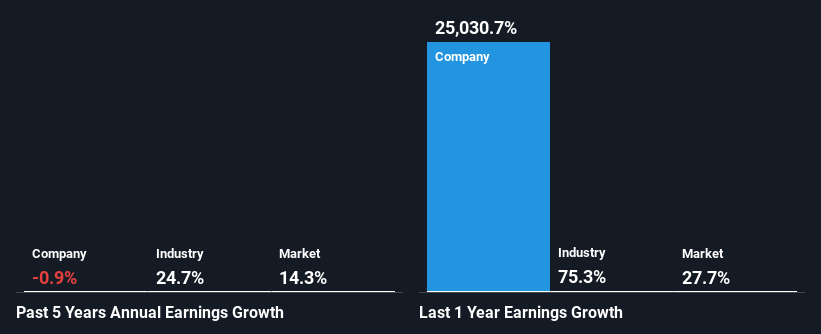Should Weakness in Urban Outfitters, Inc.'s (NASDAQ:URBN) Stock Be Seen As A Sign That Market Will Correct The Share Price Given Decent Financials?
It is hard to get excited after looking at Urban Outfitters' (NASDAQ:URBN) recent performance, when its stock has declined 25% over the past three months. But if you pay close attention, you might find that its key financial indicators look quite decent, which could mean that the stock could potentially rise in the long-term given how markets usually reward more resilient long-term fundamentals. Specifically, we decided to study Urban Outfitters' ROE in this article.
Return on Equity or ROE is a test of how effectively a company is growing its value and managing investors’ money. Put another way, it reveals the company's success at turning shareholder investments into profits.
View our latest analysis for Urban Outfitters
How Do You Calculate Return On Equity?
ROE can be calculated by using the formula:
Return on Equity = Net Profit (from continuing operations) ÷ Shareholders' Equity
So, based on the above formula, the ROE for Urban Outfitters is:
18% = US$311m ÷ US$1.7b (Based on the trailing twelve months to January 2022).
The 'return' is the amount earned after tax over the last twelve months. That means that for every $1 worth of shareholders' equity, the company generated $0.18 in profit.
What Has ROE Got To Do With Earnings Growth?
We have already established that ROE serves as an efficient profit-generating gauge for a company's future earnings. Based on how much of its profits the company chooses to reinvest or "retain", we are then able to evaluate a company's future ability to generate profits. Assuming all else is equal, companies that have both a higher return on equity and higher profit retention are usually the ones that have a higher growth rate when compared to companies that don't have the same features.
A Side By Side comparison of Urban Outfitters' Earnings Growth And 18% ROE
To start with, Urban Outfitters' ROE looks acceptable. Be that as it may, the company's ROE is still quite lower than the industry average of 33%. Additionally, the flat earnings seen by Urban Outfitters over the past five years doesn't paint a very bright picture. Not to forget, the company does have a decent ROE to begin with, just that it is lower than the industry average. So there might be other reasons for the flat earnings growth. Such as, the company pays out a huge portion of its earnings as dividends, or is faced with competitve pressures.
We then compared Urban Outfitters' net income growth with the industry and found that the average industry growth rate was 25% in the same period.
The basis for attaching value to a company is, to a great extent, tied to its earnings growth. What investors need to determine next is if the expected earnings growth, or the lack of it, is already built into the share price. This then helps them determine if the stock is placed for a bright or bleak future. One good indicator of expected earnings growth is the P/E ratio which determines the price the market is willing to pay for a stock based on its earnings prospects. So, you may want to check if Urban Outfitters is trading on a high P/E or a low P/E, relative to its industry.
Is Urban Outfitters Making Efficient Use Of Its Profits?
Urban Outfitters doesn't pay any dividend, which means that it is retaining all of its earnings. This makes us question why the company is retaining so much of its profits and still generating almost no growth? So there could be some other explanations in that regard. For instance, the company's business may be deteriorating.
Conclusion
On the whole, we do feel that Urban Outfitters has some positive attributes. Although, we are disappointed to see a lack of growth in earnings even in spite of a moderate ROE and and a high reinvestment rate. We believe that there might be some outside factors that could be having a negative impact on the business. With that said, we studied the latest analyst forecasts and found that while the company has shrunk its earnings in the past, analysts expect its earnings to grow, albeit marginally, in the future. Are these analysts expectations based on the broad expectations for the industry, or on the company's fundamentals? Click here to be taken to our analyst's forecasts page for the company.
Have feedback on this article? Concerned about the content? Get in touch with us directly. Alternatively, email editorial-team (at) simplywallst.com.
This article by Simply Wall St is general in nature. We provide commentary based on historical data and analyst forecasts only using an unbiased methodology and our articles are not intended to be financial advice. It does not constitute a recommendation to buy or sell any stock, and does not take account of your objectives, or your financial situation. We aim to bring you long-term focused analysis driven by fundamental data. Note that our analysis may not factor in the latest price-sensitive company announcements or qualitative material. Simply Wall St has no position in any stocks mentioned.


